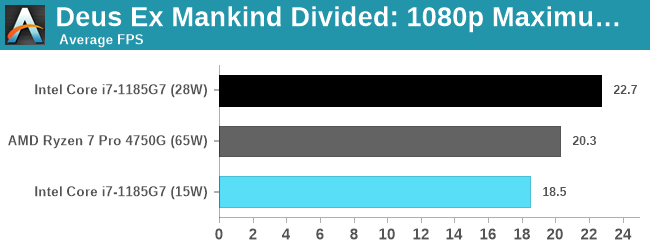Intel’s Tiger Lake 11th Gen Core i7-1185G7 Review and Deep Dive: Baskin’ for the Exotic
by Dr. Ian Cutress & Andrei Frumusanu on September 17, 2020 9:35 AM EST- Posted in
- CPUs
- Intel
- 10nm
- Tiger Lake
- Xe-LP
- Willow Cove
- SuperFin
- 11th Gen
- i7-1185G7
- Tiger King
Xe-LP GPU Performance: Deus Ex Mankind Divided
Deus Ex is a franchise with a wide level of popularity. Despite the Deus Ex: Mankind Divided (DEMD) version being released in 2016, it has often been heralded as a game that taxes the CPU. It uses the Dawn Engine to create a very complex first-person action game with science-fiction based weapons and interfaces. The game combines first-person, stealth, and role-playing elements, with the game set in Prague, dealing with themes of transhumanism, conspiracy theories, and a cyberpunk future. The game allows the player to select their own path (stealth, gun-toting maniac) and offers multiple solutions to its puzzles.
DEMD has an in-game benchmark, an on-rails look around an environment showcasing some of the game’s most stunning effects, such as lighting, texturing, and others. Even in 2020, it’s still an impressive graphical showcase when everything is jumped up to the max.


At the minimum settings, all of the integrated graphics are easily playable, with AMD winning at 15 W but the 28 W Tiger Lake goes a bit above that, within reaching distance of the desktop APU. At a more regular 1080p Maximum, the 20 FPS is perhaps a bit too slow for regular gameplay.











253 Comments
View All Comments
blppt - Saturday, September 26, 2020 - link
Sure, the box sitting right next to my desk doesn't exist. Nor the 10 or so AMD cards I've bought over the past 20 years.1 5970
2 7970s (for CFX)
1 Sapphire 290x (BF4 edition, ridiculously loud under load)
2 XFX 290 (much better cooler than the BF4 290x) mistakenly bought when I thought it would accept a flash to 290x, got the wrong builds, for CFX)
2 290x 8gb sapphire custom edition (for CFX, much, much quieter than the 290x)
1 Vega 64 watercooled (actually turned out to be useful for a Hackintosh build)
1 5700xt stock edition
Yeah, i just made this stuff up off the top of my head. I guarantee I've had more experience with AMD videocards than the average gamer. Remember the separate CFX CAP profiles? I sure do.
So please, tell me again how I'm only a Nvidia owner.
Santoval - Sunday, September 20, 2020 - link
If the top-end Big Navi is going to be 30-40% faster than the 2080 Ti then the 3080 (and later on the 3080 Ti, which will fit between the 3080 and the 3090) will be *way* beyond it in performance, in a continuation of the status quo of the last several graphics card generations. In fact it will be even worse this generation, since Big Navi needs to be 52% faster than the 2080 Ti to even match the 3070 in FP32 performance.Sure, it might have double the memory of the 3070, but how much will that matter if it's going to be 15 - 20% slower than a supposed "lower grade" Nvidia card? In other words "30-40% faster than the 2080 Ti" is not enough to compete with Ampere.
By the way, we have no idea how well Big Navi and the rest of the RDNA2 cards will perform in ray-tracing, but I am not sure how that matters to most people. *If* the top-end Big Navi has 16 GB of RAM, it costs just as much as the 3070 and is slightly (up to 5-10%) slower than it in FP32 performance but handily outperforms it in ray-tracing performance then it might be an attractive buy. But I doubt any margins will be left for AMD if they sell a 16 GB card for $500.
If it is 15-20% slower and costs $100 more noone but those who absolutely want 16 GB of graphics RAM will buy it; and if the top-end card only has 12 GB of RAM there goes the large memory incentive as well..
Spunjji - Sunday, September 20, 2020 - link
@Santoval, why are you speaking as if the 3080's performance characteristics are not already known? We have the benchmarks in now.More importantly, why are you making the assumption that AMD need to beat Nvidia's theoretical FP32 performance when it was always obvious (and now extremely clear) that it has very little bearing on the product's actual performance in games?
The rest of your speculation is knocked out of what by that. The likelihood of an 80CU RDNA 2 card underperforming the 3070 is nil. The likelihood of it underperforming the 3080 (which performs like twice a 5700, non-XT) is also low.
Byte - Monday, September 21, 2020 - link
Nvidia probably has a good idea how it performs with access to PS5/Xbox, they know they had to be aggressive this round with clock speeds and pricing. As we can see 3080 is almost maxed, o/c headroom like that of AMD chips, and price is reasonable decent, in line with 1080 launch prices before minepocalypse.TimSyd - Saturday, September 19, 2020 - link
Ahh don't ya just love the fresh smell of TROLLevernessince - Sunday, September 20, 2020 - link
The 5700XT is RDNA1 and it's 1/3rd the size of the 2080 Ti. 1/3rd the size and only 30% less performance. Now imagine a GPU twice the size of the 5700XT, thus having twice the performance. Now add in the node shrink and new architecture.I wouldn't be surprised if the 6700XT beat the 2080 Ti, let alone AMD's bigger Navi 2 GPUs.
Cooe - Friday, December 25, 2020 - link
Hahahaha. "Only matching a 2080 Ti". How's it feel to be an idiot?tipoo - Friday, September 18, 2020 - link
I'd again ask you why a laptop SoC would have an answer for a big GPU. That's not what this product is.dotjaz - Friday, September 18, 2020 - link
"This Intel Tiger" doesn't need an answer for Big Navi, no laptop chip needs one at all. Big Navi is 300W+, no way it's going in a laptop.RDNA2+ will trickle down to mobile APU eventually, but we don't know if Van Gogh can beat TGL yet, I'm betting not because it's likely a 7-15W part with weaker Quadcore Zen2.
Proper RDNA2+ APU won't be out until 2022/Zen4. By then Intel will have the next gen Xe.
Santoval - Sunday, September 20, 2020 - link
Intel's next gen Xe (in Alder Lake) is going to be a minor upgrade to the original Xe. Not a redesign, just an optimization to target higher clocks. The optimization will largely (or only) happen at the node level, since it will be fabbed with second gen SuperFin (formerly 10nm+++), which is supposed to be (assuming no further 7nm delays) Intel's last 10nm node variant.How well will that work, and thus how well 2nd gen Xe will perform, will depend on how high Intel's 2nd gen SuperFin will clock. At best 150 - 200 MHz higher clocks can probably be expected.